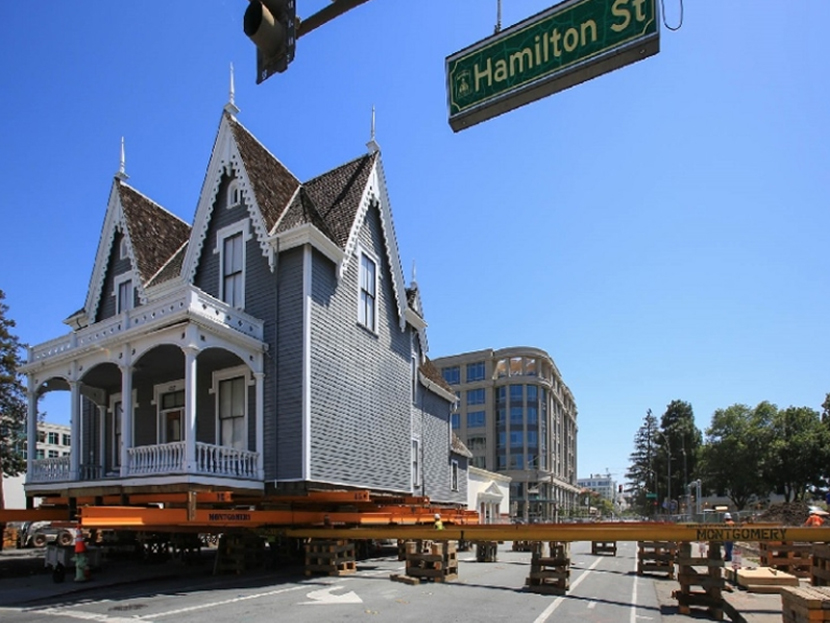Redwood City’s landmark Lathrop House has a new downtown address, but it will take a while before the mansion built by one of San Mateo County’s founding fathers fully settles in at 701 Hamilton St.
Crews last week had begun lifting and moving the stately home from its longtime site at 627 Hamilton St. toward the sidewalk in preparation for the final push Sunday morning from one side of Marshall Street to the other. At the end of a day of easy-does-it incremental progress, Lathrop House was poised next to the opposite sidewalk, ready for more precision maneuvering Monday, before finally being lowered and secured on its new foundation.
“I did actually see it move five inches,” said 88-year-old Helen Cocco, president of the Redwood City Heritage Association, which manages Lathrop House as a museum. She’d been standing on the sidewalk since early morning watching the slow-motion action. “It was so exciting. I tell you, it was magic.”
In what appears a win-win for San Mateo County and for the cause of local history, Lathrop House’s new home is a parking lot behind the county history museum, which will develop exhibit space and provide staffing. Once the newly prominent, two-story house is ready to receive visitors, it will be open more hours and will have an upstairs Redwood City history gallery, according to Mitch Postel, president of the San Mateo County Historical Association. Eventually, if a planned carriage house can be built alongside Lathrop House, visitors would be able to see those two attractions and the museum with a single admission.
Built in 1856 for Benjamin Lathrop, San Mateo County’s first clerk-recorder, the mansion initially stood where the Fox Theatre is today but was relocated to the back of the property to make room for a grammar school. The house was moved a second time in 1905, to 627 Hamilton St., where it was somewhat hidden between county offices and drew only about 10 or 15 visitors day on the three days a week that it was open.
Like a wallflower thrust into the spotlight, the Steamboat Gothic beauty stopped traffic Sunday in more ways than one. Fenced in to allow the movers safely to position cribbing and steel traveling beams under the dark gray, wood-sided house, Lathrop House hung suspended five feet above the pavement, spectacular and delicate as an elaborate, 90-ton wedding cake, festooned with white gingerbread and a front porch.
The house was supported on blocks of wooden cribbing. Two hydraulic pushers moved six roller beams measuring as long as 80 feet, which carried the house forward at the rate of three to four feet an hour. From above, the house looked like it was creeping along on enormous orange railroad tracks. Crews used a laser level to ensure that all the beams were in the same plane crossing the street, according to the county’s inspector on the job, Brent Hipsher.
Sam Garcia, the project manager for the move, said the house needed to be high enough to clear an obstacle that could not be removed, a PG&E electrical box, which contains traffic signal controls.
“We had to pick the structure up above that,” Hipsher said. “… Otherwise it would have been a lot lower to the ground.”
Initially, planners of the move had considered putting Lathrop House on a trailer and transporting it down Hamilton Street, but opted for the course least likely to damage the historic structure – inch-by-inch sideways steps across Marshall Street.
“We could do it faster,” Garcia said, “but we were trying to do it as safe as possible.”
Truebeck Construction of Redwood City was the contractor and brought in Montgomery Contractors, Inc., which specializes in house-moving, according to Garcia. Altogether, Lathrop House will be about 200 feet down the road from its old location.
On Monday, crews will begin positioning the 10-room, 3,393-square-foot treasure over its new, seismically-sound foundation, which needs to cure until Thursday. The house has to be lowered into place perfectly, with all corners and anchor bolts matching, Garcia added.
Once Lathrop House is positioned at its new address, it will need to be tented for termites, get utilities connected and other work, and Postel says it’s too soon to predict how soon it will be open for visitors. Tours and visits ceased last June in preparation for the move. All antique furnishings and objects were removed and stored in containers, and windows and walls that might be strained or damaged during the move were taped.
Cocco said Lathrop House has been a boarding house in the 1940s but when the heritage association took control in the 1970s, it was “rejuvenated” to bring it back as close as possible to the way it was when Mr. Lathrop built it. The association maintains the inside, and the county, which owns the building, is responsible for the outside. Moving Lathrop House will cost about $1.5 million, which includes the new foundation.
With the house gone, the entire block where it was located, including the former First American Title Insurance Co., will be redeveloped with a new county office building.
Garcia said he enjoyed working with Cocco and other history enthusiasts and hopes Lathrop House will attract more visitors in its more visible location. “At the end of the day, we want people to get to know the Lathrop House,” he said.






